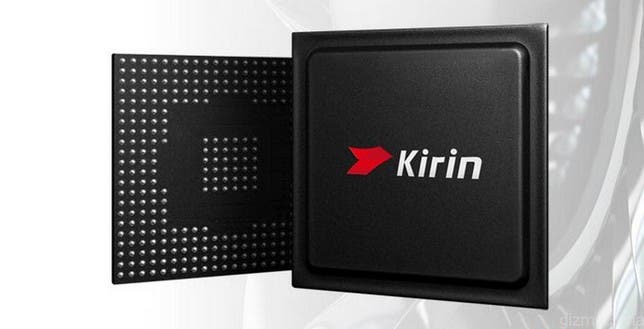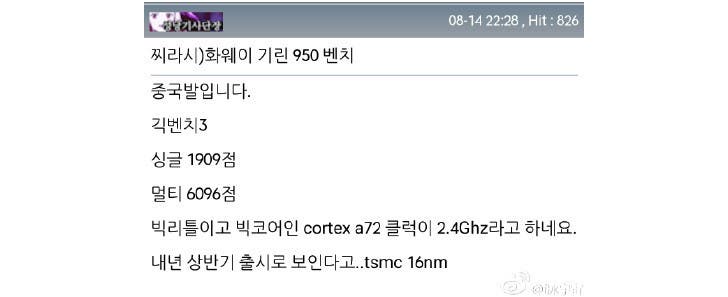Since last year Huawei has shown great potential in producing their own chipsets to run on their devices. The Huawei P8 and P8 Lite are good examples both running the Kirin 935. Despite the satisfactory performance, this still isn’t the best that Huawei has to offer, coming in both Kirin 940 and 950.
Since the first reports about the new Kirin 950, we all created good expectations that this would be the first chipset from Huawei to compete, if not surpass the best that we have in the market today. The chip that would give power to the Huawei Ascend Mate 8 and the possible Honor 7 Plus does not have a date to reach the market and in a optimistic view, until the end of this year. The Kirin 940 is expected to come in the next month in the Huawei Ascend Mate 7s and while the 950 don’t show up we can now check some details about it.
The Kirin 950 is an octa-core CPU made in the 16nm FinFET process that counts with a cluster of 4x Cortex-A72 up to 2.4GHz and another cluster of 4x Cortex-A53, besides the Mali-T860 GPU for graphic processing and the support the fast LPDDR4 RAM technology.The Kirin 950 gets a punctuation of 6.000 points in the Multi-Core Geekbench 3 Test, 20% more than the current unbeatable Exynos 7420. The 950 also did well in the single-core test reaching 1.900 points which is 30% better than performed by Exynos 7420.
We expect the Kirin 950 to debut inside the Huawei Ascend Mate 8, previously expected for September but due to the chipset delay, it would be launched early in the next year. However, talking about the Kirin 940 we expect the upcoming Mate 7S to do impressively well with it.
More details about the Kirin 940 and 950 should come with the time, and with the IFA date in the corner that shouldn’t take a long time, only by then we can confirm if the info is totally accurate or a bit of overstatement. More details we will cover, for now leave your thoughts about the Huawei’s newest SoCs, can they do well with the competition?
[ Source ]






Of course it is not! 😉
The truth is that Samsung Exynos M1 reaches the top of geekbench:
Single-Core: 2.136
Multi-Core: 7.497
Source: http://www.weibo.com/5673255066/CvjC3ilc0?from=page_1005055673255066_profile&wvr=6&mod=weibotime&type=comment#_rnd1439891714014
I can’t reach that page, it’s in Chinese asking a weibo account?
Follow this link and click at its included source-links:
http://www.gforgames.com/gadgets/nvidia-denver-2-vs-exynos-m1-apple-a9-a9x-next-gen-benchmarks-48178/
… or take this:
http://www.sammobile.com/2015/08/17/samsungs-upcoming-soc-with-mongoose-cpu-cores-showcases-dominating-performance/
Knowing Samsung’s history of cheating in benchmarks?
To be fair it’s not Antutu (the bench mainly used for cheating). Geekbench only measures Memory/RAM performance (the only performance that matters IMO, with EMMC speeds a distant second) so it’s harder to cheat there, unless -of course- you let your phone get too hot during those runs so that any throttling will not be represented.
But if the above is true we’d soon know (does the phone get more hot during particular runs when compared to regular use?).
you probably need a gasoline powered phone to handle that SoC
Maybe it will feature in the second generation Huawei Nexus 6 ?
its just amazing. they say “Geekbench 3 scores are calibrated against a baseline score of 2500 (which is the score of an Intel Core i5-2520M @ 2.50 GHz). ” … even an i7-4790k, which is the highest 4-core intel chip in the processor charts, is only 17k (or 15.5k 32bit, not sure how to compare it). I mean, that is a very serious desktop chip, with many dozens of times more power available to it, and is used mostly in systems well above $1000.
My current desktop, an unlocked ivy bridge i5, is not quite twice as powerful, while using roughly 100 times as much power.
Admittedly this bench is specific to the cpu and memory subsystem, and my desktop shines in other areas as well .. my graphics card is a decent chunk of my power budget. my ssd (a smasung 830) is still very likely faster than any SoC’s nand even next year, since they would never use 8 chips like they need to to fill the channel